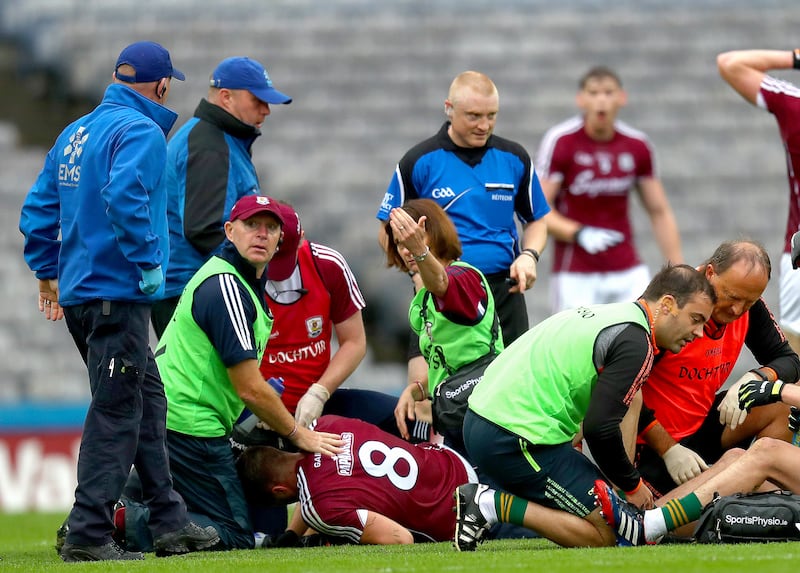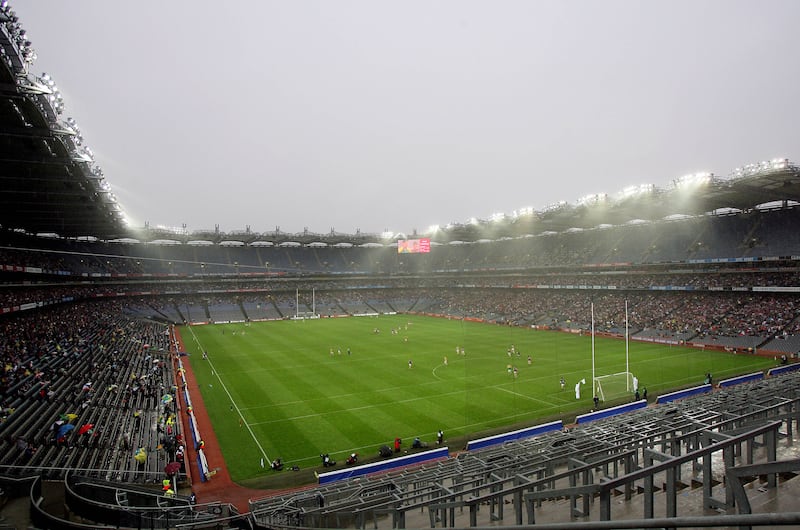Remember it. Dublin in a rainstorm. August 2008. A different country and, certainly, a different sport. Kerry and Galway met for a classic All-Ireland football quarter-final, the first ever under floodlights. There was something about the colours - maroon moving through the green and gold - that brought to the mind’s eye the cream of the game: the expressionist counties at play.
The evening was drenched and in defiance, both teams engaged in a thrilling shootout. Kerry survived. Galway had the consolation of an all-time performance from Michael Meehan, who struck 0-10. There were so many storylines that the inclusion of Paul Conroy, Galway’s minor captain the previous summer, went under the radar.
“I didn’t set the world on fire,” Conroy would tell The Irish Times some 10 years later. Still, it was a show of faith in a young player whose maturity belied his years.
Conroy remains the unique link to Galway’s wildly uneven story since their 2001 All-Ireland final triumph. That 2008 game is a bittersweet memory for the county. It contained the traditional virtues of Galway football, but they lost, 1-21 to 1-16 against a Kerry team chasing a three-in-a-row. They would not win a football match in Croke Park for another decade.
Ken Early on World Cup draw: Ireland face task to overcome Hungary, their football opposites
The top 25 women’s sporting moments of the year: 25-16 revealed with Vikki Wall, Lara Gillespie and Ireland Sevens featuring
World Cup 2026 draw: Team-by-team guide to Ireland’s opponents
Irish rugby is a good place to be, thanks to people such as Dave Fagan
Conroy was playing that day as well, in the Super 8s game in Croke Park. Kerry were the opponents and it was raining again. By then, Conroy was well established as both the central column and moral conscience of the Galway team. Twenty minutes in, he used the greasy surface to slide at speed to try and secure a loose ball around the middle of the field and collided with Kerry’s Sean O’Shea who was trying the same manoeuvre. The result was a sickening collision, a long delay and confirmation that evening that Conroy had suffered a double leg break: a tibia and fibia in his left and a hairline fracture in his right. He was 29 years old.
Frank Doherty was Conroy’s manager with the St James’ senior team from 2013 to 2015.
[ Joe Canning: Analysis must outweigh emotion after an All-Ireland final defeatOpens in new window ]
“You get a bit of a shock and fright. I was focusing on his motion on the ground to see how bad it could be. As time went on, I just said that this is not looking good. Paul is such a tremendous athlete and such a good guy and you want to just see him jump up and be all right. But it was clear it was more serious than that and of course the doubt was there that he may not come back as the super athlete he was for St James and Galway. But he is a very determined man.”
The story of Conroy’s return is not just that he managed to make a full athletic recovery from the injury, but he is arguably enjoying the finest phase of his career. The immediate aftermath left him in a Dublin hospital, watching Galway defeat Kerry on his phone. “That put my mind off what was happening for 30 minutes or so,” he said a few weeks afterwards. “And I’m sure the medication they put me on helped too.”
But the reality of the days and months of rehabilitation ahead of him was daunting. He spent the first weeks in a wheelchair. He had a steel rod inserted into the fibia. The pain was intense for the first fortnight, so much so he was kept on morphine for a time. The sympathy for his predicament was genuine but the world quickly moved on.
Conroy is a secondary school teacher and was due to begin a new role in Claregalway College that September. He was unable to return to work until January of 2019. A further six months of rehabilitation culminated in a return to the Galway bench for the round three qualifier against Mayo the following summer. In essence, he missed the 2019 intercounty year.

It wasn’t until January of 2020 that he made his competitive return, in the FBD league, against Mayo. By coincidence that game also marked the return of Mayo’s Tom Parsons, who had suffered a similarly horrendous injury in the 2018 championship season playing against Galway. If Conroy suffered from doubts during that year-and-a-half recovery process, he kept them to himself. A few weeks after the injury, he voiced confidence in just following the programme.
“That is the kind of individual he is,” Frank Doherty says. “In the time I got to know him, he was always around the club to help and talk to guys. He picked up a couple of minor injuries and he was always there. He is a cool character. There are no meltdowns. His Dad was a selector with me for three years. You can see where Paul gets it - there is a coolness there with Sean as well but he is a Connemara man and that steely grit of determination is there. His focus would have been to show that he had another few years left in the tank. And he is proving it now.”
Reflecting on the time at a media event this March, Conroy did allow that he questioned the future.
“To me that was always like a break in the middle of a career, if you like. Then you realise when you come out the other side of it that you don’t have that much time left. I’m 32 at the minute and I’m enjoying my football. But I obviously know that I don’t have an awful amount of years left, so I’m trying to enjoy them as much as I can. Some people would have said, ‘you’ll find it hard to come back,’ and you try and stay away from those sorts of people. You try and stay with the people who have the experience. I didn’t really think I wouldn’t get back but there are those kinds of doubts.”
But the point is not so much that Conroy returned as that he has been there as the constant force and voice throughout a delicate period for Galway football. He emerged from St James, a young suburban club set up in 1994 to serve the growing communities of Renmore and Mervue, as the leader of a talented group that swept the boards at underage level. In 2007, he captained Galway to a landmark All-Ireland minor championship, the county’s first since 1986.
“He was the great white hope of Galway football then,” Doherty recalls. “He was such a fantastic footballer as a young guy in what he could do and how he could carry a ball. He would nearly beat teams on his own when he was younger. Then he had the minors and made his senior debut the year after. Everybody knew what he was capable of but turning it from club to county is still a big leap. He took it in his stride.”
They beat Derry by 1-10 to 1-9. When the senior teams meet on Saturday, Conroy will be the lone survivor from that game.
On that rain drenched Saturday night in the city in 2008, Conroy had good reason to believe there were plenty of good times ahead for his county. In fact, the senior team was about to enter a deeply volatile period and Galway was one of the counties swept away during a swift, left field transformation of Gaelic football’s tactical evolution.

Conroy’s was an ever present-name on Galway team sheets in good times and bad. His versatility meant he could play anywhere: nominally a midfielder, he could operate as full forward or on the wing. There were days when he kicked sublime points and others when he seemed content to be a workhorse and let others shine. But he seemed to belong with a group of high calibre players like Gareth Bradshaw, Gary Sice, Gary O’Donnell and Finian Hanley who emerged just as Galway’s golden period was beginning to fade.
Eight years would pass before Conroy would win his next Connacht championship with Galway. By then, Kevin Walsh had begun to put a defensively robust system in place. The confirmation that over 50 club players had declined invitations to attend Galway trials seemed to reflect the growing apathy within the county. It was something to which Conroy alluded in a television interview moments after Galway had stunned Mayo in the 2016 Connacht semi-final.
“It hasn’t really sunk in yet. We weren’t given a chance coming up here today. A lot of lads turned down the chance to come in. I don’t know whether they were up for it or what their story was.”
The depth of Conroy’s enduring commitment to the Galway cause shone through in that campaign and it carried him through the long months of recovery, when he had to trust that he would return as the same robust, physically dominant athlete. In what has been a break-out season for Joyce’s Galway - promotion to Division One, winning the Connacht championship and edging out Armagh in that gripping quarter-final - Conroy has been one of the players of the season.
He has been scoring consistently and sometimes like a marquee forward - 0-3 against Mayo in that tight championship game, 0-6 against Roscommon and 1-2 against Down in the initial stages of the championship. But his key role is still that of ball-winner and distributor and as a sort of director of smart decisions around the hectic middle third of the field.
[ Kevin McStay: GAA needs to incorporate a specific eye-gouging ruleOpens in new window ]
“He is just a go-to guy on the pitch,” Doherty says. “If you are in a bit of bother and need to just take the sting out of the game, you go to Paul. All great players have something within them that they know when to accelerate or just step into the pocket and pop a little handpass and keep possession. He knows when to turn the gas on and when he goes, he usually takes the right option. I have seen him in tight corners in games and suddenly, he pops up at full forward and the ball is in the net.
“I remember being involved with Michael Meehan back in Caltra too and he had that. I think his stock has risen in a big way. And you have to give PJ credit too because he wants that ball played into the forwards. He was a genius himself as a footballer and I think he has instilled that from the halfway line going forward, we give that direct pass. Against Derry, like Armagh, there will be a packed defence and one pass can split that. I would love to see Paul get to an All-Ireland senior final, a one-off game where anything can happen.”
Certainly, Saturday evening will not be easy. But it represents Galway’s best chance of a return to the big stage for two decades. Through that long absence Paul Conroy has been a guiding force.






